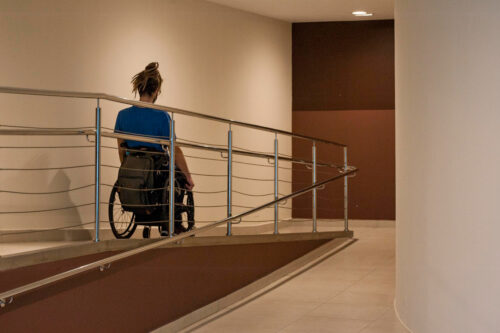How to Address Steep Slopes in Wheelchair Ramp Installations

Ottawa, known for its charming architecture and welcoming community, continuously seeks to improve accessibility for everyone. Among the various aspects of accessibility, ensuring that wheelchair ramps are safe and navigable stands out as particularly significant. It’s not just about compliance with regulations but about allowing individuals who use wheelchairs the freedom to access spaces without barriers. Steep slopes in wheelchair ramps can pose safety risks, making it difficult for users to navigate. Addressing these concerns is essential for creating a more inclusive community.
Having the right slope on a ramp can make a world of difference in ensuring ease of access and reducing potential hazards. When the incline is too steep, it becomes challenging and poses a risk for accidents. The right slope offers a smooth transition, ensuring that individuals relying on wheelchairs, as well as caregivers, can move freely and confidently. In a city like Ottawa, where seasonal changes can affect surface conditions, getting this aspect right is crucial for overall safety and accessibility.
Understanding Wheelchair Ramp Slopes
A wheelchair ramp slope refers to the angle of the ramp that provides access between different elevation levels. It might seem like a technical detail, but it’s vital for both safety and comfort. A gentle slope ensures that users can move up and down the ramp with minimal effort, while a steep slope can be difficult and hazardous.
In Ottawa, like in most regions, there are specific guidelines and regulations to direct the construction of ramps. These rules help maintain uniformity and safety across public and private properties. The general guideline suggests a ratio of 1:12, meaning for every inch of vertical rise, there should be at least 12 inches of ramp length. This ratio helps prevent excessive strain on wheelchair users and their caregivers, ensuring a smoother and safer transition.
To visualize this, think of a ramp as a gentle hill. You wouldn’t want to slog up a steep hill, especially in a wheelchair. The gentle incline makes rolling up a breeze and ensures that when you’re coming down, you aren’t faced with a precarious descent. Complying with these guidelines ensures everyone, from planners to builders, contributes to making spaces more accessible.
Common Problems with Steep Slopes
Having a steep slope in a ramp design often results in several problems that can’t be overlooked. First and foremost, there’s the risk of safety hazards. A steep incline can lead to loss of control, which may cause falls or injuries, especially in icy or wet conditions common during Ottawa’s winters. It’s crucial to consider these factors when first planning and constructing ramps.
Another issue is the physical strain placed on wheelchair users and their companions. Maneuvering a wheelchair up a steep slope demands more effort, potentially leading to fatigue or physical strain. This could deter people from visiting certain places if they perceive the journey as too arduous, thereby restricting their independence.
Lastly, steep ramps are not only a challenge for users but can also wear out more quickly. With increased pressure and usage, the ramp surface may show signs of wear sooner, leading to the need for more frequent repairs or replacements. Proper planning and installation of ramps with suitable slopes can help mitigate these issues, extending the lifespan of the ramp while ensuring user safety.
Solutions for Addressing Steep Slopes
Addressing steep slopes in ramp installations requires a strategic approach. It starts with rethinking the ramp layout. By increasing the length of the ramp, you can achieve a gentler slope, making it safer for users. This might mean extending the ramp to cover more ground horizontally rather than vertically, ensuring it’s both functional and easy to navigate.
A useful way to manage steeper terrains is by incorporating landings and switchbacks. Landings provide spaces where users can pause, take a break, and safely turn if needed. These resting spots help divide the ramp into smaller, more manageable sections. Switchbacks, which enable a zig-zag pattern, help in reducing the slope and making the ascent more gradual.
When it comes to materials, choose those that enhance grip and stability. Opt for non-slip surfaces, especially considering Ottawa’s frequent wet or icy conditions. Materials like textured concrete or rubberized coatings can offer additional traction, ensuring safety even during adverse weather conditions. Investing in quality materials and thoughtful design not only enhances user safety but also extends the life of the ramp.
Professional Installation Benefits
Opting for professional installation of wheelchair ramps provides numerous advantages. Experts have a keen understanding of local and national building codes, ensuring that all installations meet the required guidelines. This compliance guarantees not only legal safety but also the practical safety of users.
Professional installers can also provide customized solutions tailored to unique property layouts in Ottawa. Whether it’s historical homes, modern buildings, or challenging landscapes, experienced teams can design ramps that fit seamlessly and function effectively. Their expertise can often foresee potential obstacles and address them during the planning stage, ensuring timely and effective installations.
Additionally, professional installation means having access to a range of high-quality materials and up-to-date techniques. This ensures durability against Ottawa’s seasonal challenges, including snow and ice, which can test the resilience of poorly constructed ramps. Relying on experienced installers gives peace of mind that the ramp will remain a reliable accessibility solution for years.
Ensuring Long-Term Ramp Safety
To keep ramps in optimal condition, regular maintenance is essential. Here are some tips to help ensure long-lasting safety and functionality:
– Inspect the Surface: Regularly check the ramp for signs of wear or damage, such as cracks or loose sections, which could cause accidents or further deterioration.
– Clear Debris: Keep the ramp free of debris like leaves or snow to maintain its anti-slip properties and prevent accidents.
– Apply Anti-Slip Treatments: Especially before winter, consider adding textured paint or anti-slip strips to maintain grip and safety during icy conditions.
– Seasonal Checks: Prepare the ramp for each season. For Ottawa winters, ensure that the ramp is structurally sound and protected from ice buildup that could impede accessibility or cause damage.
Periodic inspections by professionals can also highlight any issues that may not be immediately visible. Small fixes can prevent larger problems, preserving the ramp’s integrity over time. Regular care and attention help ensure that those in wheelchairs can continue to enjoy safe and easy access throughout the year.
Making Accessibility a Priority in Ottawa
Promoting accessibility is not just about meeting legal requirements; it’s about fostering an inclusive society where everyone can participate fully. Investing in well-designed, professionally installed ramps extends beyond mere adherence to regulations. It demonstrates a commitment to inclusivity and caring for the community.
Businesses and homeowners in Ottawa are encouraged to view these features as integral to creating welcoming environments. Beyond the practical benefits, accessible solutions reflect values of empathy and equality. By prioritizing accessibility, we not only enhance the quality of life for wheelchair users but contribute to a more inclusive and welcoming Ottawa for all individuals.
Choosing the right slope for a ramp is crucial in providing safe and accessible paths for those who use wheelchairs. If you’re looking to enhance accessibility, Regional Ramp is here to help. Explore how a well-designed wheelchair ramp slope can make a difference. We’re committed to providing tailored solutions to ensure that your property is accessible and welcoming to everyone in Ottawa.

